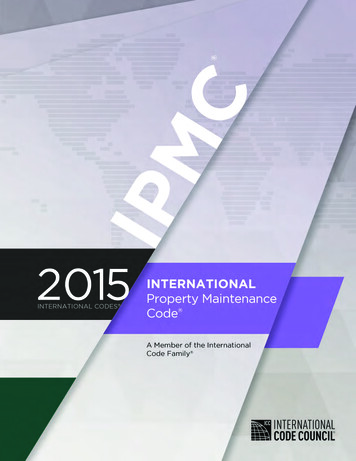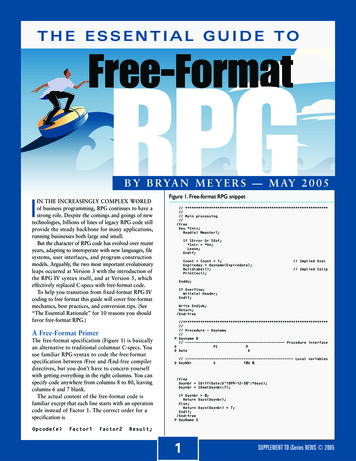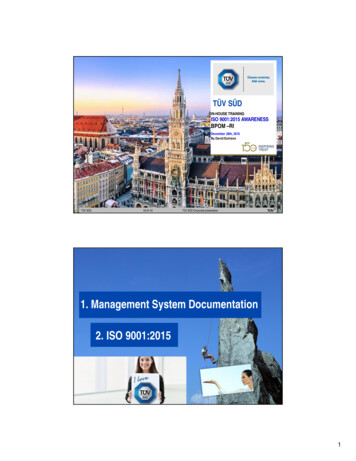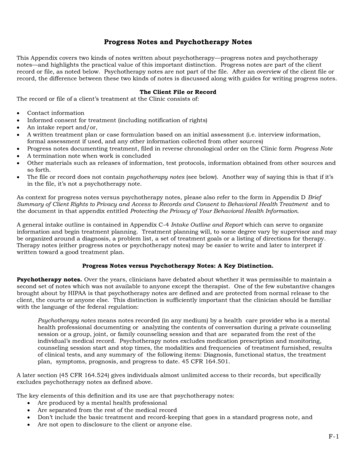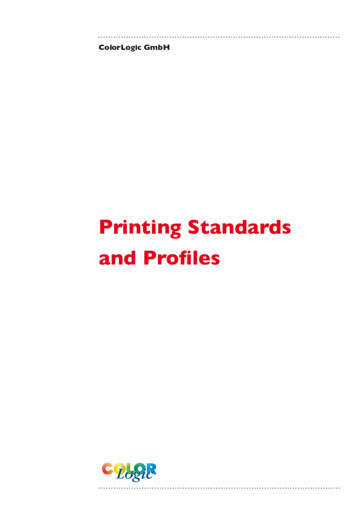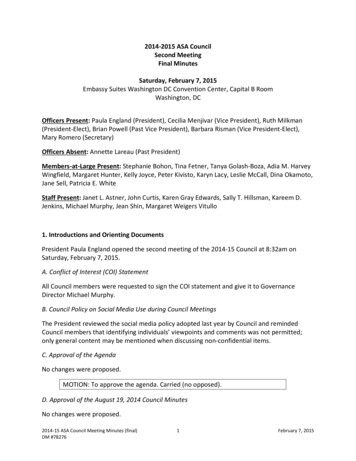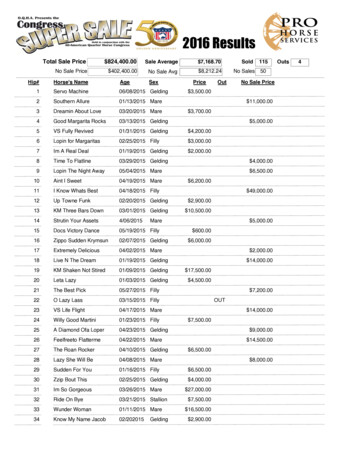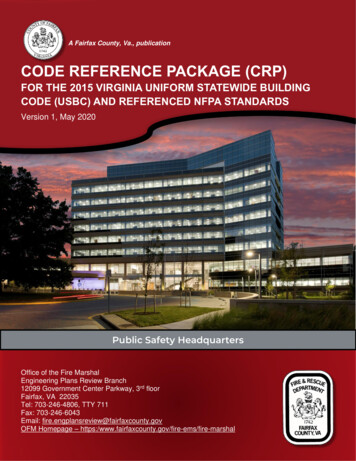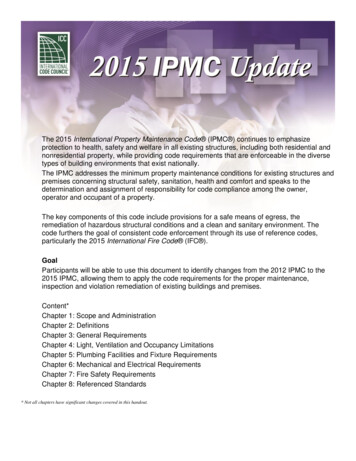
Transcription
The 2015 International Property Maintenance Code (IPMC ) continues to emphasizeprotection to health, safety and welfare in all existing structures, including both residential andnonresidential property, while providing code requirements that are enforceable in the diversetypes of building environments that exist nationally.The IPMC addresses the minimum property maintenance conditions for existing structures andpremises concerning structural safety, sanitation, health and comfort and speaks to thedetermination and assignment of responsibility for code compliance among the owner,operator and occupant of a property.The key components of this code include provisions for a safe means of egress, theremediation of hazardous structural conditions and a clean and sanitary environment. Thecode furthers the goal of consistent code enforcement through its use of reference codes,particularly the 2015 International Fire Code (IFC ).GoalParticipants will be able to use this document to identify changes from the 2012 IPMC to the2015 IPMC, allowing them to apply the code requirements for the proper maintenance,inspection and violation remediation of existing buildings and premises.Content*Chapter 1: Scope and AdministrationChapter 2: DefinitionsChapter 3: General RequirementsChapter 4: Light, Ventilation and Occupancy LimitationsChapter 5: Plumbing Facilities and Fixture RequirementsChapter 6: Mechanical and Electrical RequirementsChapter 7: Fire Safety RequirementsChapter 8: Referenced Standards* Not all chapters have significant changes covered in this handout.
2015 IPMC UpdateFormat of the 2015 IPMCPage 2
2015 IPMC UpdateChapterCode Section20152012102.3102.3Section TitleDescription of ChangeApplication ofother codesAllows use of the International ExistingBuilding Code as an option for repairs,alterations or additions to an existing building.105.2105.2Alternativematerials,methods andequipmentLanguage has been added to require the code official to provide reasonsin writing when an alternative is not approved.Page 3
2015 IPMC UpdateChapter 2: DefinitionsCode SectionSection cription of ChangeDefinition of “Cost of such demolition or emergency repairs” added.Definition of “Historicbuilding” added.Page 4
2015 IPMC UpdateChapterCode SectionSection TitleDescription of Change20152012704.1.2NewFire departmentconnectionRequirements for a sign indicating the location of the fire departmentconnection when the connection is not visible to approaching fireapparatus704.2.1.3NewNewInstallation nearcookingappliances andbathroomsLimits smoke alarm installations near cooking appliances and bathrooms.704.2.1.4.704.2.4NewSmoke detectionsystemAllowance for smoke detectors providedas part of a fire alarm system as analternative to providing single ormultiple-station smoke alarms.Page 5
2015 IPMC UpdateSummary A means to determine if a building is eligible to be classified as anhistoric building under the IPMC is now defined.Signage requirements to allow fire departments to locate the firedepartment connection in a timely manner are now prescribed.A mechanism for code officials to prohibit installation of smokealarms near cooking appliances and bathrooms is now prescribed.An alternative manner for compliance with smoke alarmrequirements if the building is equipped with a fire alarm system isnow prescribed.Page 6
2015 IPMC Overview and Update10/31/2014Accreditation The International Code Council has been accredited asan Authorized Provider by the International Associationfor Continuing Education and Training (IACET). As a result of their Authorized Provider accreditation status, ICCis authorized to offer IACET CEUs for its programs that qualifyunder the ANSI/IACET Standard. You will obtain .1 CEUs for this webinar2015 IPMC Overview and Update12015 InternationalProperty MaintenanceCode Overview and UpdateBased on the 2015 International PropertyMaintenance Code (IPMC )Description This webinar provides an overview of thepurpose and scope of the IPMC and of thechanges from the 2012 IPMC to the 2015 IPMC. It identifies changes in organization and coderequirements and the applicability of theserequirements to the maintenance, inspectionand violation remediation of existing buildingsand premises.2015 IPMC Overview and UpdateCopyright 2014 International Code Council31
2015 IPMC Overview and Update10/31/2014Welcome Dave BowmanManager of CodesInternational Code Council2015 IPMC Overview and Update4Questions and Answers At the end of thepresentation, pleasetype your questionsinto the Q & A portionof Adobe ConnectBox. The facilitator\speakerwill respond to yourquestions at the endof the webinar.Type yourquestions intohere.2015 IPMC Overview and UpdateThen hit enteror the sendbutton.5Polling Questions2015 IPMC Overview and UpdateCopyright 2014 International Code Council62
2015 IPMC Overview and Update10/31/2014IPMC Purpose The purpose of the IPMC is to protect the public health,safety and welfare by requiring existing buildings andpremises to meet minimum standards for structuralintegrity, occupancy, plumbing facilities, mechanical andelectrical equipment and fire safety.2015 IPMC Overview and Update7Adoption & EnforcementThe adoption and enforcement of the IPMC will helpprovide the following for existing buildings andpremises: A minimum level of protection against firehazards (Chapter 7). A safe, unobstructed means of egress(Chapter 7). A minimum level of protection against unsafestructural conditions, building deteriorationand other unsafe conditions (Chapter 3). Clean and sanitary buildings (Chapter 3). A suitable environment for the public to live,visit, work or conduct business (Chapter 4, 5and 6).2015 IPMC Overview and Update8ConsequencesImproper application of the IPMCcould result in: Deterioration of the builtenvironment. Unsafe structural conditions. Unsafe fire hazard conditions. Health hazards. Delay in emergency egress.2015 IPMC Overview and UpdateCopyright 2014 International Code Council93
2015 IPMC Overview and Update10/31/2014Format of the 2015 IPMC2015 IPMC Overview and Update10Chapter 1:Scope and Administration11Section 101.2—Scope Applies to all structures. Details: Administration. Enforcement. Penalties. Occupancy limitations. Provide minimum maintenance standards. Determines responsibility for code compliance.2015 IPMC Overview and UpdateCopyright 2014 International Code Council124
2015 IPMC Overview and Update10/31/2014Section 102.6—Historic buildings The code official maydeviate from the strictapplication of the code. The building mustsubstantially comply withthe spirit and intent of thecode.2015 IPMC Overview and Update13Section 102.3—Application of othercodesRepairs, alterations, additions and changes of occupancyshall comply with the: IBC IFGC IMC NFPA 70 *IEBC*Added to the 2015 – will be discussed later2015 IPMC Overview and Update14Section 104.3—Right of entry The code official is authorized to enter astructure or premises for the purpose of aninspection only when granted entry by any of thefollowing: The owner. A person who legally occupies the premises. An owner who has properly obtained permission fromthe occupant.2015 IPMC Overview and UpdateCopyright 2014 International Code Council155
2015 IPMC Overview and Update10/31/2014Section 106.2—Notice ofviolation The code official must initiate an action tocorrect the violation. Any action taken on the premises shall becharged against the real estate. In accordance with Section 107.2015 IPMC Overview and Update16Section 106.5—Abatement ofviolation Regardless of the imposition of penalties, thejurisdiction may institute action to correct all orpart of a violation.2015 IPMC Overview and Update17Unsafe Structures andEquipment—Section 108 Any structure or piece ofequipment that isconsidered unsafe, unlawfulor unfit for habitation issubject to condemnation.2015 IPMC Overview and UpdateCopyright 2014 International Code Council186
2015 IPMC Overview and Update10/31/2014Section 108.1.1—UnsafestructureAny of the following can contribute to anunsafe structure: Lack of fire safeguards. Unsafe equipment. Damage or dilapidation. Danger of collapse.2015 IPMC Overview and Update19Unsafe StructureSection 108.1.1 – Unsafe garage structure dueto failed wall.2015 IPMC Overview and Update20Unsafe StructureSection 108.1.1 – Unsafe structure due tofoundation failure.2015 IPMC Overview and UpdateCopyright 2014 International Code Council217
2015 IPMC Overview and Update10/31/2014Section 108.1.2—UnsafeequipmentEquipment that is hazardousor in disrepair, such as: Boiler equipment. Elevator or moving stairway. Electric wiring or device. Flammable liquid containers.2015 IPMC Overview and Update22Section 108.1.3—Structure unfitfor human occupancy Unfit for human occupancy are: Insanitary conditions. Severe dilapidation or disrepair. Infestation or contamination. Lack of ventilation or illumination. Lack of sanitary or heating facilities or other essentialequipment. Endangerment due to the location of the structure.2015 IPMC Overview and Update23Section 108.1.4—UnlawfulstructuresUnlawful structures can be those that are: Overcrowded. Erected unlawfully. Occupied unlawfully. Unlawful structures should be condemned.2015 IPMC Overview and UpdateCopyright 2014 International Code Council248
2015 IPMC Overview and Update10/31/2014Section 108.1.5—Dangerousstructure or premises This section provides for conditions that render astructure dangerous. If any of the conditionsexist, a determination can be made that thestructure or premises is dangerous.2015 IPMC Overview and Update25Section 108.1.5—Dangerousstructure or premisesExamples include: Inadequate means of egress under the adoptedbuilding. Damaged by natural disaster, such as ahurricane or earthquake. Inadequate light, ventilation, mechanical orplumbing systems. An abandoned structure.2015 IPMC Overview and Update26Emergency Measures—109Section 109.1—Imminent dangerThe code official is required to take emergencymeasures when the occupant is in danger andcould be harmed.This is not always an easy or obvious decision.2015 IPMC Overview and UpdateCopyright 2014 International Code Council279
2015 IPMC Overview and Update10/31/2014Section 110—Demolition A structure deemed unreasonable to repair shallbe ordered demolished by the code official. A structure is capable of being repaired, theowner has the option to raze or repair. If the code official has the building razed, itshould be charged against the property.2015 IPMC Overview and Update28Means of Appeal—111A Board of Appeals must be established.An appeal (other than imminent danger) preventsthe code official from pursuing compliance of theviolation.2015 IPMC Overview and Update29Changes in 2015:Chapter 1 Scope and AdministrationAddition of the International Existing Building Code (IEBC)20152012102.3102.3Allowing use of the International ExistingBuilding Code as an option for repairs,alterations or additions to an existingbuilding.2015 IPMC Overview and UpdateCopyright 2014 International Code Council3010
2015 IPMC Overview and UpdateAdministrationSection102.3Page 110/31/2014Addition of the IEBC IPMC [A] 102.3 Application of other codes. Repairs,additions or alterations to a structure, or changes ofoccupancy, shall be done in accordance with theprocedures and provisions of the International BuildingCode, the International Existing Building Code,International Energy Conservation Code, InternationalFire Code, International Fuel Gas Code, InternationalMechanical Code, International Residential Code,International Plumbing Code and NFPA 70. Nothing in thiscode shall be construed to cancel, modify or set aside anyprovision of the International Zoning Code.2015 IPMC Overview and Update31Administration Addition of the IEBC In the 2012/2013/2014 code change cycle all provisionsfor existing buildings were removed from Chapter 34 ofthe 2012 International Building Code and reference wasmade to the 2015 IEBC for all work proposed for existingbuildings. The IEBC provides many compliance options for anowner and designer to choose. Prescriptive compliance Work are compliance Performance compliance2015 IPMC Overview and Update32Changes in 2015:Chapter 1 Scope and AdministrationExpanding code official responsibilities for review ofalternate materials, methods and equipment20152012105.2105.2Added language to require the codeofficial to provide reasons in writing whenan alternative is not approved.2015 IPMC Overview and UpdateCopyright 2014 International Code Council3311
2015 IPMC Overview and UpdateAdministration Section105.2Page 310/31/2014Alternative methodsIPMC [A] 105.2 Alternative materials, methods andequipment. The provisions of this code are not intended toprevent the installation of any material or to prohibit any methodof construction not specifically prescribed by this code, providedthat any such alternative has been approved. An alternativematerial or method of construction shall be approved where thecode official finds that the proposed design is satisfactory andcomplies with the intent of the provisions of this code, and thatthe material, method or work offered is, for the purposeintended, at least the equivalent of that prescribed in this code inquality, strength, effectiveness, fire resistance, durability andsafety. Where the alternative material, design or method ofconstruction is not approved, the code official shall respond inwriting, stating the reasons the alternative was not approved.2015 IPMC Overview and Update34Administration Alternative methods In order to ensure effective communication and dueprocess of law, the reasons for denial of alternativemethods, materials or equipment are required to be inwriting. The language is coordinated across all of the I-codes forconsistency of enforcement.2015 IPMC Overview and Update35Chapter 2:Definitions36Copyright 2014 International Code Council12
2015 IPMC Overview and Update10/31/2014Changes in 2015:Chapter 2 Definitions20152012202202Definition of “Cost of such demolitionor emergency repairs” added.2015 IPMC Overview and Update37DefinitionsNew definition added:Cost of such demolition or emergency repairsSECTION 202: DEFINITIONSSection 202Page 9 COST OF SUCH DEMOLITION OR EMERGENCY REPAIRS.The costs shall include the actual costs of the demolition orrepair of the structure less all revenues obtained if salvage wasconducted prior to demolition or repair. Costs shall also include,but not be limited to, all expenses incurred or necessitatedrelated to demolition or emergency repairs, such as asbestossurvey and abatement if necessary; costs of inspectors, testingagencies or experts retained relative to the demolition oremergency repairs; costs of testing; surveys for other materialsthat are controlled or regulated from being dumped in a land-fill;title searches; mailing(s); postings; recording; and all attorneyfees expended for recovering of the cost of emergency repairsor to obtain or enforce an order of demolition made by a codeofficial, the governing body or board of appeals.2015 IPMC Overview and Update38Definitions New definition added:Cost of such demolition or emergency repairs This new definition summarizes the existing language ofthe code text in Sections 106.3, 109.5 and 110.3, whichmake reference to the jurisdiction’s ability to recovercosts. This new definition provides a basis for a jurisdiction todetermine reimbursable costs when invoicing thebuilding owner for demolition work performed by othersat the direction of the jurisdiction.2015 IPMC Overview and UpdateCopyright 2014 International Code Council3913
2015 IPMC Overview and Update10/31/2014DefinitionsGeneral Definitions20152012202202Definition for “Historic Building” was added.2015 IPMC Overview and Update40Definitions New definition added:Historic buildingSECTION 202: DEFINITIONSSection 202Page 9 HISTORIC BUILDING. Any building or structure that is one ormore of the following:1. Listed or certified as eligible for listing, by the StateHistoric Preservation Officer or the Keeper of theNational Register of Historic Places, in the NationalRegister of Historic Places.2. Designated as historic under an applicable state orlocal law.3. Certified as a contributing resource within a NationalRegister or state or locally designated historic district.2015 IPMC Overview and Update41Definitions New definition added: Historicbuilding This new definition provides thecode official the means to determineif a building is eligible to beclassified as an historic buildingunder the IPMC. This new definition was added toallow jurisdictions to consistentlyevaluate historic buildings.2015 IPMC Overview and UpdateCopyright 2014 International Code Council4214
2015 IPMC Overview and Update10/31/2014Chapter 3: GeneralRequirements43Chapter 3: General Requirements Exterior areas Sanitation Grading and drainage Pavement Weeds Rodent harborage Exhaust vents Accessory structures Motor vehicles Defacement of property Swimming pools, spas, hottubs Clean, sanitary, good repair Enclosure around private pools Gates self-latching and selfclosing Components and equipmentHandrails and guardsRubbish and garbagePests2015 IPMC Overview and Update44Chapter 3: General Requirements Exterior structure Interior structure Unsafe conditions abated Clean, sanitary Exterior surfaces protected Unsafe conditions listed Premises identification Structural integrity Structural integrity Interior surfaces Walls and roofs preventmoisture Stairs and walking surfaces Doors Stairs, decks Chimneys Handrails and guards2015 IPMC Overview and UpdateCopyright 2014 International Code Council4515
2015 IPMC Overview and Update10/31/2014Exterior Property AreasSection 302.7 – Wall not maintained in good repair.2015 IPMC Overview and Update46Exterior Property AreasSections 302.2 and 302.3 – Failure to preventaccumulation of water on property and maintain parkinglot.2015 IPMC Overview and Update47Exterior Property AreasSection 302.7 – Failure to maintain accessory structure(fence) in good repair.2015 IPMC Overview and UpdateCopyright 2014 International Code Council4816
2015 IPMC Overview and Update10/31/2014Exterior Property AreasSections 302.1 and 302.5 – Failure to maintain in a cleanand safe manner and keep free from possible ratharborage.2015 IPMC Overview and Update49Exterior Property AreasSections 302.4 and 302.8 – Weeds in excess of 10inches and motor vehicle in major state of disrepair.2015 IPMC Overview and Update50Interior StructureSections 108.1.1, 108.1.3 and 305.2 – Main beam cutto accommodate vent pipe.2015 IPMC Overview and UpdateCopyright 2014 International Code Council5117
2015 IPMC Overview and Update10/31/2014FoundationSections 305.2 and 305.3 – Interior foundation wallbulging, water infiltration, mortar voids.2015 IPMC Overview and Update52Rubbish and GarbageSections 308.1, 308.2 and 308.3 – Improper disposalof rubbish and garbage.2015 IPMC Overview and Update53Interior structureSection 305.3 – Ceiling water damaged, peelingpaint, plaster damage.2015 IPMC Overview and UpdateCopyright 2014 International Code Council5418
2015 IPMC Overview and Update10/31/2014Rubbish and garbageSection 308.3 – Failure to maintain exterior property inclean manner and failure to dispose of rubbishproperly.2015 IPMC Overview and Update55Interior structureSections 305.3, 307.1 and 604.3 – Failure to maintainrailing, windows, ceiling (holes), and electrical wiring.2015 IPMC Overview and Update56Interior structureSections 305.3, 305.4, 305.5 and 307.1 – Failure tomaintain stairs, railing and interior surface (no railing,holes and uneven treads).2015 IPMC Overview and UpdateCopyright 2014 International Code Council5719
2015 IPMC Overview and Update10/31/2014Chapter 4: Light, Ventilationand Occupancy Limitations58Chapter 4 Light, Ventilation, andOccupancy Limitations Lighting Habitable spaces glazingarea 8% of floor area 60 watt light for every 200square feet of halls andstairways Light in all areas to permitmaintenance, safeoccupancy, and utilizationof appliances, fixtures,equipment Ventilation Openable windows 45% ofglazed area Bathrooms air exhausted tooutdoors Cooking facilities prohibitedin rooming units ordormitory units Toxic and irritating fumesventilated to outside Clothes dryer exhaust2015 IPMC Overview and Update59Chapter 4 Light, Ventilation, andOccupancy Limitations Occupancy Limitations PrivacyMinimum room widthsMinimum ceiling heightsBedroom and living room requirements: Room areasBedrooms cannot be only access to exits or other roomsAccess to water closet on same storyKitchens and non-habitable spaces not used for sleeping Overcrowding: minimum areas of rooms based onoccupants2015 IPMC Overview and UpdateCopyright 2014 International Code Council6020
2015 IPMC Overview and Update10/31/2014Chapter 5: Plumbing Facilitiesand Fixture Requirements61Chapter 5 Plumbing Facilitiesand Fixture Requirements Required Facilities Each dwelling mustcontain one: Water closet. Bathtub or shower. Lavatory.2015 IPMC Overview and Update62Chapter 5 Plumbing Facilitiesand Fixture Requirements Public toilet facilities Toilet room privacy Location Bathrooms should notbe located more thanone floor away in: Location of employeefacilities A toilet room should be nomore than one story aboveor below and within 500feet (152 m) of theemployees’ work area. Hotels. Rooming houses. Dormitories.2015 IPMC Overview and UpdateCopyright 2014 International Code Council6321
2015 IPMC Overview and Update10/31/2014Chapter 5 Plumbing Facilitiesand Fixture Requirements Floor surface Toilet rooms shall havea smooth, hard andnonabsorbent floor forgood sanitation. This does not apply todwelling units.2015 IPMC Overview and Update64Chapter 5 Plumbing Facilities andFixture Requirements Plumbing Fixtures Water System Sanitary drainage system Storm Drainage2015 IPMC Overview and Update65Chapter 6: Mechanical andElectrical Requirements66Copyright 2014 International Code Council22
2015 IPMC Overview and Update10/31/2014Chapter 6 Mechanical andElectrical Requirements Heating facilities Dwellings provided withfacilities to maintain 68Degrees F. Heat supply requiredduring cold months Work spaces provided withfacilities to maintain 65Degrees F. Location of thermostat Mechanical Equipment Chimney or vent to removeproducts of combustion Clearances tocombustibles Safety controls maintained Adequate combustion air Labeled energyconservation devices2015 IPMC Overview and Update67Chapter 6 Mechanical andElectrical Requirements Electrical Required for everyoccupied building Service size System hazards Receptacles required Luminaires required Flexible cordsprohibited permanent Elevators anddumbwaiters ASME A17.1 Maintenance Duct Systems Free of obstructions2015 IPMC Overview and Update68Chapter 7: Fire Safetyrequirements69Copyright 2014 International Code Council23
2015 IPMC Overview and Update10/31/2014Chapter 7 Fire SafetyRequirements Means of egress Continuousunobstructed path Aisle widths Doors readilyopenable without key Emergency escapeopenings operationaland available2015 IPMC Overview and Update70Chapter 7 Fire SafetyRequirements Fire ProtectionSystems Sprinklers systemsinspected and tested Fire departmentconnection Smoke alarms Where requiredLocation limitationsPower supplyInterconnection2015 IPMC Overview and Update71Changes in 2015:Chapter 7: Fire Safety RequirementsFire Department Connection20152012704.1.2NEWRequirements for a sign indicating the location of the firedepartment connection when the connection is not visibleto approaching fire apparatus.2015 IPMC Overview and UpdateCopyright 2014 International Code Council7224
2015 IPMC Overview and Update10/31/2014Fire Safety RequirementsFire department connectionSection704.1.2Page 25 [F] 704.1.2 Fire department connection.Where the fire department connection is notvisible to approaching fire apparatus, the firedepartment connection shall be indicated by anapproved sign mounted on the street front or onthe side of the building. Such sign shall have theletters “FDC” not less than 6 inches (152 mm)high and words in letters not less than 2 inches(51 mm) high or an arrow to indicate thelocation. Such signs shall be subject to theapproval of the fire code official.2015 IPMC Overview and Update73Fire Safety Requirements Firedepartment connection Provides consistency with the requirements of theInternational Fire Code for fire department connectionsserving existing buildings. Provides fire departments the information they need toaccess the fire department connection in a timelymanner.2015 IPMC Overview and Update74Changes in 2015:Chapter 7 Fire Safety RequirementsSmoke Alarm ng smoke alarm installations near cooking appliancesand bathrooms.2015 IPMC Overview and UpdateCopyright 2014 International Code Council7525
2015 IPMC Overview and Update10/31/2014Fire Safety RequirementsSmoke alarm installation Section704.2.1.3Page 26[F] 704.2.1 Installation near cooking appliances. Smokealarms shall not be installed in the following locations unless thiswould prevent placement of a smoke alarm in a location requiredby Section 704.2.1.1 or 704.2.1.2.1. Ionization smoke alarms shall not be installed less than20 feet (6.1 m) horizontally from a permanently installedcooking appliance.2. Ionization smoke alarms with an alarm-silencing switchshall not be installed less than 10 feet (3 m) horizontallyfrom a permanently installed cooking appliance.3. Photoelectric smoke alarms shall not be installed lessthan 6 feet (1.8 m) horizontally from a permanentlyinstalled cooking appliance.2015 IPMC Overview and Update76Fire Safety RequirementsSmoke alarm installationSection704.2.1.4Page 26 [F] 704.2.2 Installation near bathrooms.Smoke alarms shall be installed not less than 3feet (0.91 m) horizontally from the door oropening of a bathroom that contains a bathtubor shower unless this would prevent placementof a smoke alarm required by Section 704.2.1.1or 704.2.1.2.2015 IPMC Overview and Update77Fire Safety RequirementsSmoke alarm installation Provides mechanism for code officials to prohibitinstallation of smoke alarms near cooking appliancesand bathrooms that could inadvertently activate a smokealarm based on the steam produced at these locations. Reduces the number of false alarms. Maintains the minimum level of safety by requiringcompliance with the base installation requirements ofSections 704.2.1.1 and 704.2.1.2.2015 IPMC Overview and UpdateCopyright 2014 International Code Council7826
2015 IPMC Overview and Update10/31/2014Changes in 2015:Chapter 7 Fire Safety RequirementsSmoke detection system20152012704.2.4NEWAllowance for smoke detectorsprovided as part of a fire alarmsystem as an alternative toproviding single or multiplestation smoke alarms.792015 IPMC Overview and UpdateFire Safety RequirementsSmoke detection system Section704.2.4Page 26907.2.11.5 (IBC [F] 907.2.11.5) Smoke detection system. Smokedetectors listed in accordance with UL 268 and provided as part of thebuilding’s fire alarm system shall be an acceptable alternative to singleand multiple-station smoke alarms and shall comply with the following:1.2.3.The fire alarm system shall comply with all applicablerequirements in Section 907.Activation of a smoke detector in a dwelling unit orsleeping unit shall initiate alarm notification in thedwelling unit or sleeping unit in accordance with Section907.5.2.Activation of a smoke detector in a dwelling unit orsleeping unit shall not activate alarm notificationappliances outside of the dwelling unit or sleeping unit,provided that a supervisory signal is generated andmonitored in accordance with Section 907.6.5.2015 IPMC Overview and Update80Fire Safety RequirementsSmoke alarm installation Provides mechanism for designers to comply with smokealarm requirements in an alternative manner if thebuilding is equipped with a fire alarm system. Provides consistency between the International FireCode and the International Property Maintenance Coderegarding the provisions for smoke alarms in existingbuildings.2015 IPMC Overview and UpdateCopyright 2014 International Code Council8127
2015 IPMC Overview and Update10/31/2014Summary A means to determine if a building is eligible to be classified as anhistoric building under the IPMC is now defined. Signage requirements to allow fire departments to locate the firedepartment connection in a timely manner is now prescribed. A mechanism for code officials to prohibit installation of smokealarms near cooking appliances and bathrooms is now prescribed. An alternative manner for compliance with smoke alarmrequirements if the building is equipped with a fire alarm system isnow prescribed. Definition of “Cost of such demolition or emergency repairs”.2015 IPMC Overview and Update82Questions and Answers At the end of thepresentation, pleasetype your questionsinto the Q & A portionof Adobe ConnectBox. The facilitator\speakerwill respond to yourquestions at the endof the webinar.Type yourquestions intohere.2015 IPMC Overview and UpdateThen hit enteror the sendbutton.83CertificatesTo request a certificateplease email:ICCCertificates@iccsafe.org2015 IPMC Overview and UpdateCopyright 2014 International Code Council8428
2015 IPMC Overview and Update10/31/2014Dave Bowmandbowman@iccsafe.org888-422-7233Ext: 4323Contact Information85Code Opinions888-422-7233Ext. 7732Contact Information86Code Alert2015 IPMC Overview and UpdateCopyright 2014 International Code Council8729
2015 IPMC Overview and Update10/31/2014ICC StoreTo Purchase:Visit the ICC Store athttp://shop.iccsafe.org/2015 IPMC Overview and Update88Next Feature Topic Webinars2015 U
particularly the 2015 International Fire Code (IFC ). Goal Participants will be able to use this document to identify changes from the 2012 IPMC to the 2015 IPMC, allowing them to apply the code requirements for the proper maintenance, inspection and violation

